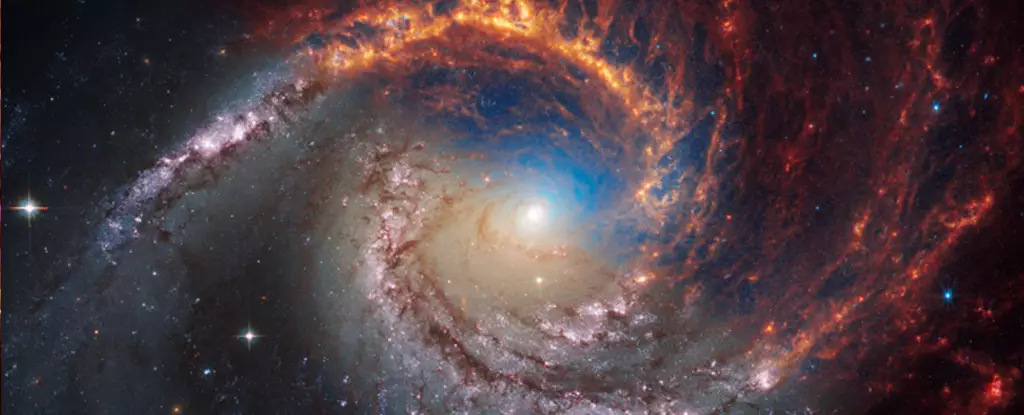Spiral galaxies have an enchanting quality that captures the imagination of anyone fascinated by the wonders of Nature. Recently, the James Webb Space Telescope (JWST) captured incredible images of 19 spiral galaxies, providing a mesmerizing display of their intricate details. These images were obtained as part of the Physics at High Angular resolution in Nearby GalaxieS (PHANGS) program, which aims to enhance our understanding of galactic structure and evolution by studying the interaction between gas, star formation, and galactic evolution.
Unlike its predecessor, the Hubble Space Telescope, which primarily operates in visible light, UV light, and a small portion of infrared light, the JWST is capable of observing in both near-infrared (NIR) and mid-infrared (MIR) light. This ability allows the JWST to reveal different and more detailed aspects of the galaxies it observes. In the high-resolution images provided by the JWST, gas and dust emitting infrared light appear as a rich red color, showcasing the telescope’s remarkable capability in detecting such emissions, even from the densely packed galactic cores where supermassive black holes reside.
Within the captivating JWST images, one can observe bright diffraction spikes in the galactic centers of some spiral galaxies. These spikes are caused by an enormous amount of light and can indicate the presence of an active supermassive black hole or an unusually high concentration of stars. According to Eva Schinnerer, a staff scientist at the Max Planck Institute for Astronomy in Heidelberg, Germany, “That’s a clear sign that there may be an active supermassive black hole, or the star clusters toward the center are so bright that they have saturated that area of the image.” These insights provide valuable hints about the dynamics and composition of the galactic centers.
Age and Colorful Variety of Stars
The stellar populations within spiral galaxies vary depending on their distance from the galactic center. Stars residing near the center tend to be significantly older compared to those found in the arms. The younger stars in the arms exude a vibrant blue hue, having shed their cocoon of gas and dust during their early formation. Clusters of orange-colored stars indicate even younger stellar formations that are still actively accreting material and evolving. Erik Rosolowsky, a professor of physics at the University of Alberta, explains, “These are where we can find the newest, most massive stars in the galaxies.” This differentiation in stellar ages and colors paints a vivid picture of the ongoing evolution and star formation within these galactic structures.
The release of the JWST images of spiral galaxies accompanied side-by-side comparisons with views captured by the Hubble Space Telescope. These comparisons demonstrate how observing different wavelengths of light can reveal distinct aspects or obscure certain details within the galaxies. The PHANGS program utilizes various telescopes to observe galaxies across different wavelengths, including visible light, infrared light, UV light, and even radio waves. Infrared light, invisible to the human eye, is transformed into visible colors to make the images interpretable. For instance, in the JWST image of NGC 628, the blue color represents old stars emitting the shortest detectable wavelengths of light, whereas the Hubble image appears more yellow and washed out due to the longest wavelengths it senses.
The spiral arms in these galaxies hold great significance for astronomers, as they provide key insights into how galaxies evolve, maintain, and shut off star formation. These arms resemble waves traveling through space, rather than a collective movement of individual stars. As Erik Rosolowsky explains, “We think of these like waves, and their spacing tells us a lot about how a galaxy distributes its gas and dust.” By studying the characteristics and patterns of these arms, researchers gain a better understanding of the complex mechanisms involved in the life cycle of stars within galaxies.
Since the commencement of its science operations, the JWST has provided astronomers with an overwhelming amount of data. The recent release of these stunning images is just a fraction of the larger data collection, which includes a catalog of approximately 100,000 star clusters. The potential for analysis and research utilizing this wealth of data surpasses what any single team could handle. As Erik Rosolowsky states, “The amount of analysis that can be done with these images is vastly larger than anything our team could possibly handle.” Thus, the JWST’s discoveries will continue to fuel research for years and decades to come, uncovering new insights into the captivating nature of spiral galaxies.
The breathtaking images captured by the JWST offer a glimpse into the awe-inspiring beauty and intricate details of spiral galaxies. These images, alongside the comprehensive data collected by the PHANGS program, shed light on the complex processes that govern galactic structure and evolution. The JWST’s ability to see in both NIR and MIR light opens up new frontiers of exploration and unveils aspects of the universe that were previously hidden from view. This remarkable telescope truly represents a gateway to limitless discoveries, enabling researchers to unravel the mysteries of the cosmos, one image at a time.



Leave a Reply